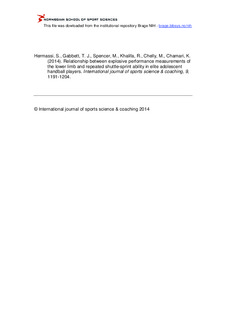| dc.contributor.author | Hermassi, Souhail | |
| dc.contributor.author | Gabbett, Tim | |
| dc.contributor.author | Spencer, Matt | |
| dc.contributor.author | Khalifa, Riadh | |
| dc.contributor.author | Chelly, Mohamed | |
| dc.contributor.author | Charmari, Karim | |
| dc.date.accessioned | 2015-10-27T10:52:45Z | |
| dc.date.available | 2015-10-27T10:52:45Z | |
| dc.date.issued | 2014-12-22 | |
| dc.identifier.citation | International Journal of Sports Science & Coaching. 2014, 9, 1191-1204 | nb_NO |
| dc.identifier.uri | http://hdl.handle.net/11250/2358099 | |
| dc.description | © 2014 Multi-Science Publishing | nb_NO |
| dc.description.abstract | This study investigated the relationship between performance measures of the lower-limb and repeated shuttle-sprint ability (RSSA) in elite adolescent handball players. Twenty-two male handball players (age: 17.7 ± 0.3 years) participated in the study. Subjects underwent measurements of lower-limb maximal strength (1-RM half back squat), explosive power (force-velocity test), jumping ability (squat and counter-movement jumps), sprinting velocities over the first step (VS) and the first 5 m (V5) of a 15 m sprint, and Yo-Yo Intermittent Recovery Test, Level 1. The players were tested for RSSA using a protocol of 6 repetitions of maximal 2 x 15-m shuttle sprints with 180° turns (~6 s) departing every 20 s. RSSA results were evaluated in three ways: best time in a single trial (RSSAbest), decrement (RSSAdec) and total time (RSSATT). The correlations of RSSA with the assorted fitness measures varied considerably. The RSSATT and RSSAdec were positively associated with 1-RM half back squat (r = 0.78 and r = 0.68 respectively; p< 0.01). Significant correlations were also found between RSSATT and RSSAbest and absolute peak power of the lower limb (r = -0.81 and -0.66, respectively; p<0.01). There was a moderate correlation between first step sprinting velocities and RSSATT (r= -0.71; p< 0.01). The RSSA test score has a moderate to large association with other explosive power measurements in elite adolescent handball players. RSSA may provide a useful composite index on responses to training or rehabilitation, and is very suitable for monitoring athletic performance of the lower-limbs of elite adolescent handball players. | nb_NO |
| dc.language.iso | eng | nb_NO |
| dc.publisher | Multi-Science Publishing | nb_NO |
| dc.subject | power | nb_NO |
| dc.subject | repeated shuttle-sprint ability | nb_NO |
| dc.subject | strength | nb_NO |
| dc.subject | vertical jump | nb_NO |
| dc.subject | youth handball | nb_NO |
| dc.title | Relationship between explosive performance measurements of the lower limb and repeated shuttle-sprint ability in elite adolescent handball players | nb_NO |
| dc.type | Journal article | nb_NO |
| dc.type | Peer reviewed | nb_NO |
| dc.subject.nsi | VDP::Social science: 200::Social science in sports: 330::Physical education and sport psychology: 333 | nb_NO |
| dc.source.journal | International Journal of Sports Science & Coaching | nb_NO |
| dc.description.localcode | Seksjon for fysisk prestasjonsevne / Department of Physical Performance | nb_NO |
